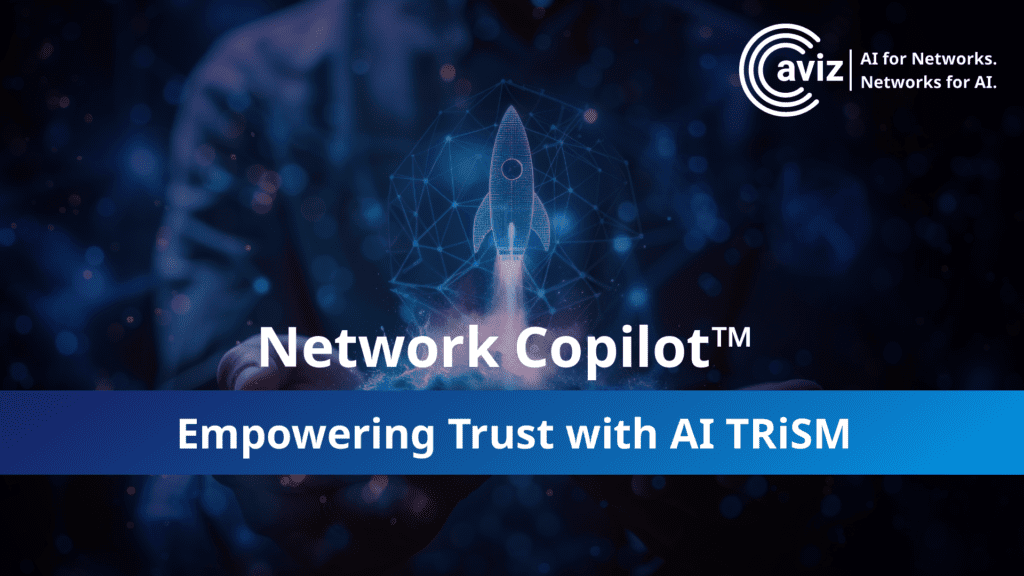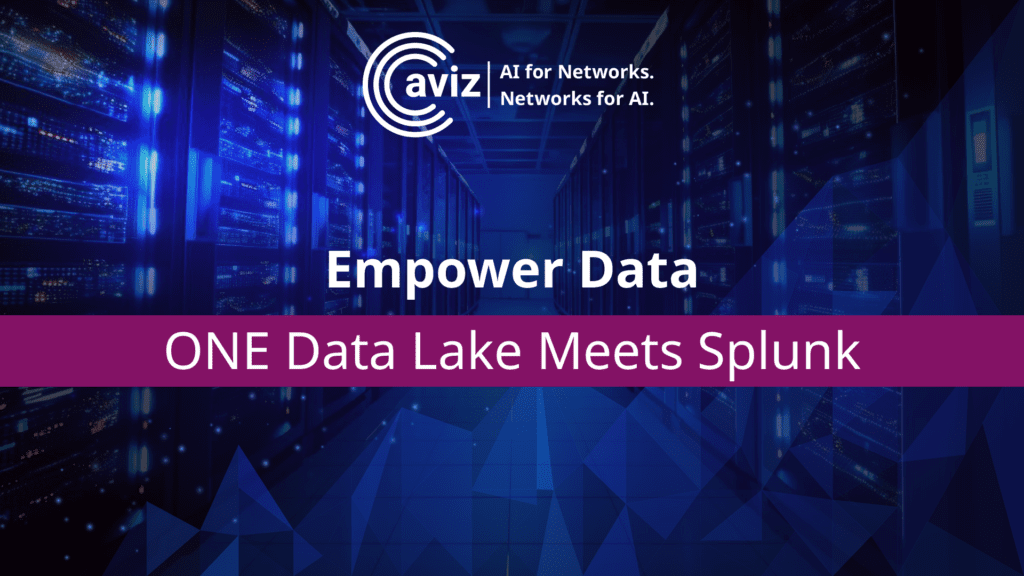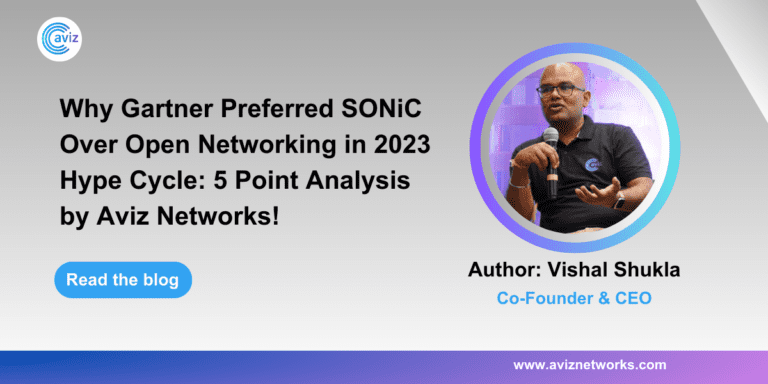Gartner just published their Enterprise Networking Hype Cycle for 2023. The first thing I noticed was that Gartner had replaced “Open Networking” with “SONiC” in its 2023 chart. In fact, the report firmly stated “Open networking has been replaced on the Hype Cycle with SONiC, which garners the most client interest of any open networking technology.”
Gartner not only swapped it, but pulled the timeline from 5-10 years to 2-5 years. This in turn shows SONiC’s acceleration that open networking in general was never able to achieve.
Aviz Networks, being a community SONiC leader in the enterprise market, felt that it was time that Gartner sees networking as we see it. We had already predicted this shift and put our thoughts here: “open vs open source networking”.
In this blog, I will go over our five-point analysis based on our insights on why this shift has happened and the path forward.


Aviz Networks’ 5 Point Analysis
1. Open networking has become a cliché
A true open networking model promised that the networks can be open for choosing any hardware or software. The promise was to bring down the TCO (by CapEx and OpEx), increase the choices by removing lock-ins (on hardware and software), and standardize the operating system layer (by enabling standard APIs).
In the past decade, many open networking companies (such as Cumulus) started with a portion of open networking vision where they focused on disaggregating the hardware and software while keeping the software proprietary. These companies called themselves as open networking companies, but essentially they were disaggregated NOS companies.
While these Network Operating System (NOS) companies proved that the disaggregated model works, they failed to deliver on the entire vision of open networking because it was simply a disaggregation model, which provided partial promises of open networking.
The eventual sale of most of these NOS companies to specific vendors made it clear that while disaggregated NOS works, it is not open enough – it is not future-proof!

2. Incumbent networking vendors and public cloud competed with open networking
Open networking by definition should have been open for the entire networking ecosystem. Big incumbents who owned more than 90% share of the networking market were not a part of open networking in the past decade, as open networking meaning got reduced to just having a disaggregated proprietary NOS.
Public cloud adoption was another big trend – which was completely missed by open networking vendors. It created a void in the open networking value proposition. Only multi-cloud/hybrid-cloud startups or existing incumbent vendors were able to solve the integration problem via their end-to-end vertical integrated stack.
Open networking vendors (typically start-ups) were not able to survive long enough competing with incumbent giants. These startups were typically focused on the battle of “my BGP is better”. This wrong kind of competition resulted in spending energy on reinventing the wheel instead of real innovation and coming up with a solution that customers needed (open source based control, choices on hardware and software, public cloud enablement, and finally the TCO savings generated from both CapEx and OpEx).
3. Disaggregated NOS (under open networking label) came with a lock-in
Disaggregated NOS companies often used the term open networking which gave customers an impression that the NOS was open source and there was no lock-in. However, that was not true.
Customers who started with their disaggregated NOS journey later figured out that while some components of the NOS were built on open source, the code itself was not open source. Further, they were slowly getting locked-in to a vertical stack that was not as mature as incumbent vendors—all of that while paying 15-20% less than proven systems from incumbent vendors.
Customers eventually also figured out that if the operating system is owned by a company that’s the worst lock-in you can get into. Time after time it’s been proven that the competition between ASIC vendors has brutally hurt the end customers. Cumulus and Bigswitch are good examples of that. While the companies consolidated, the customers lost on open networking promises and an open network became a locked network.
4. Customers got CapEx savings but OpEx spend did not change
TCO savings was one of the important selling points of disaggregation (under the umbrella of open networking) that came mainly from choosing the cheapest hardware. Customers liked the savings part and the element of choice because it gave them a way to lower their CapEx by reducing the hardware price.
The incumbent vendors (Industry mainstream vendors) addressed this by lowering the price of their hardware. The customers with huge deployments from incumbent vendors simply used quotes from “open networking” vendors to bring down the prices of hardware. Though the incumbent vendors did not like it, they still did it—as they pushed the margins towards OpEx.
Open networking vendors did not have an OpEx savings story as the disaggregated NOS price and support were essentially OpEx. This approach of doing CapEx-based TCO savings only helped in the beginning but it did not survive for long as the OpEx piece was still not solved.
5. SONiC completes the open networking vision at the right place and time with proven examples
Microsoft had figured out the issue with the disaggregation model way back and worked on a true open networking solution, which they named SONiC. That is open networking done the right way. By the time the disaggregated NOS companies started to consolidate, SONiC was getting steam in the 2018-2019 time frame.
It had all the elements of open networking. It was open sourced and had a thriving community. It was also well supported by all networking vendors and its quality improved to deployment grade. This provided the true benefits to the customers which open networking promised. Here’s a quick summary of SONiC’s advantages:
- Choice: SONiC ecosystem enables any white box or incumbent vendor switches for customers.
- Control: This ground-breaking NOS does not belong to anyone, so there will never be a lock-in. Customers now can standardize their NetOps on top.
- Savings: SONiC not only enables customers to save on CapEx, but also on OpEx (as NOS is free and customers pay only for support).
Gartner’s shifts – aligned with what customers are looking for. The path forward!
In my conversations with customers, before I start talking about SONiC, I often ask – what are the goals they are trying to achieve? Typically every networking team gives us some of these inputs on what they are looking for:
- Latest speeds & feeds and ASIC functionalities for next-generation workloads
- Future-proof networks with zero dependency on a single vendor
- Minimize budget spikes with every refresh (save on TCO in a consistent and predictable manner)
- Network open for in-house control and innovation
- Standardized NOS API layer for any NOS (proprietary or open source) with minimal spend on NetOps
While Microsoft and a few other F100 companies have demonstrated that these problems can be solved with SONiC, enterprise customers have questions about how they can do it exactly like them. Many times, we hear customers asking the following questions and looking for an objective answer or a process that is consistent and predictable:
- How can a customer get incumbent vendors like experience with SONiC?
- How can SONiC be normalized for consistent behavior across multiple vendors, while still being 100% open source?
- How to calculate precise TCO savings over the next few years in the multi-vendor environment (multi-vendor = any hardware and any NOS)?
- How to enable in-house innovation without hiring multiple engineering experts in-house?
- How to get enterprise-grade support irrespective of a switch or ASIC vendor?
- How to integrate with other applications (be it in private or in public cloud)?
We, at Aviz Networks, are working with our partners, community and customers to accelerate SONiC adoption. Our team has developed the processes, commercial ecosystem and an entire end to end open networking stack that is truly open for any ASIC, any switch, any NOS and any cloud, while future proofing it for SONiC as the foundation.
If you have already started or are thinking about exploring the SONiC path, you can schedule a demo or contact us for a free strategy review session. Being at the forefront of this revolution, I will be happy to host a free demo/call with you and help you maximize your SONiC success while you introduce it in the mix of any other NOS in your existing environments.




